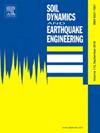交通循环应力作用下路基粉质粘土的原位冻结特性
IF 4.2
2区 工程技术
Q1 ENGINEERING, GEOLOGICAL
引用次数: 0
摘要
寒区路基受到冻结和交通荷载的耦合作用。对于低渗透或低地下水位的路基,原位冻胀在总冻胀变形中起着至关重要的作用。考虑交通诱导的竖向循环应力和水平循环剪应力的影响,在封闭体系下进行了一系列冻结试验。实验结果表明,冻结过程包括过冷、自由水冻结和膜水冻结过程。增加垂直循环应力幅值促进固结,降低含水量,提高局部过冷性和临界核形成概率。竖向循环应力的加载频率和幅值都是影响土壤冻结过程的因素。水平循环剪切应力作用下,随应力幅值和频率的增加,自发成核温度先升高后降低。当竖向循环应力和水平循环剪切应力同时作用时,由于固结较大,初始含水量较低,临界晶核更容易形成。在封闭体系中,饱和哈尔滨粉质粘土的原位冻胀主要表现为水冰相变引起的体积膨胀和土骨架中未填微孔的相变。循环应力对单位体积孔隙水相变土体原位冻胀率的影响从低到高依次为垂直循环应力、水平循环剪应力和垂直循环应力与水平循环剪应力相结合的复合循环应力。最后,建立了考虑竖向循环应力和水平循环剪应力影响的饱和哈尔滨粉质粘土原位冻胀率预测模型。本文章由计算机程序翻译,如有差异,请以英文原文为准。
In-situ freezing characteristics of subgrade silty clay under traffic-induced cyclic stresses
Subgrades in cold regions undergo the coupling effect of freezing and traffic loads. In-situ frost heave plays an essential role in total frost heave deformation for subgrades with low permeability or low groundwater levels. A series of freezing tests were conducted under a closed system, considering the effects of traffic-induced vertical cyclic stress and horizontal cyclic shear stress. The experimental results show that the freezing process consists of supercooling, free water freezing, and film water freezing processes. Increasing vertical cyclic stress amplitude promotes consolidation and reduces water content, enhancing localized supercooling and critical nuclei formation probability. Loading frequency and amplitude of vertical cyclic stress are both influencing factors for soil freezing process. Under horizontal cyclic shear stress, the spontaneous nucleation temperature rises first and then falls with increasing stress amplitude and frequency. When vertical cyclic stress and horizontal cyclic shear stress are applied together, the critical crystal nuclei get much easier to form due to the larger consolidation and lower initial water content. In the closed system, in-situ frost heave of saturated Harbin silty clay includes the volume expansion of water-ice transformation and phase change induced unfilled micropores in the soil skeleton. Cyclic stress increases the in-situ frost heave ratio of the soil by 25 %–63 % per unit volume of pore water phase transformation, with effectiveness from low to high are vertical cyclic stress, horizontal cyclic shear stress, and complex cyclic stress combining vertical cyclic stress and horizontal cyclic shear stress. Finally, an in-situ frost heave ratio prediction model of saturated Harbin silty clay was established, considering the effects of vertical cyclic stress and horizontal cyclic shear stress.
求助全文
通过发布文献求助,成功后即可免费获取论文全文。
去求助
来源期刊

Soil Dynamics and Earthquake Engineering
工程技术-地球科学综合
CiteScore
7.50
自引率
15.00%
发文量
446
审稿时长
8 months
期刊介绍:
The journal aims to encourage and enhance the role of mechanics and other disciplines as they relate to earthquake engineering by providing opportunities for the publication of the work of applied mathematicians, engineers and other applied scientists involved in solving problems closely related to the field of earthquake engineering and geotechnical earthquake engineering.
Emphasis is placed on new concepts and techniques, but case histories will also be published if they enhance the presentation and understanding of new technical concepts.
 求助内容:
求助内容: 应助结果提醒方式:
应助结果提醒方式:


